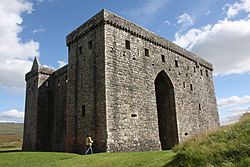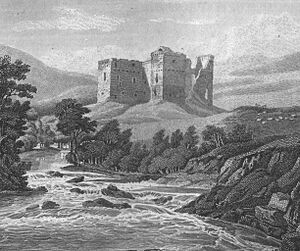Hermitage Castle facts for kids
Quick facts for kids Hermitage Castle |
|
|---|---|
| Near Newcastleton, Roxburghshire, Scotland GB |
|

Hermitage Castle
|
|
| Type | First phase: motte and bailey Second phase: tower house/keep with barmkin |
| Site information | |
| Owner | Historic Scotland |
| Open to the public |
Yes |
| Condition | Partially ruined |
| Site history | |
| Built | First phase: c.1240 Second phase: mid 14th century |
| Built by | First phase: Nicholas de Soulis Second phase: William Douglas, 1st Earl of Douglas |
| In use | Until 1705 |
| Materials | First phase: timber Second phase: stone |
Hermitage Castle is an old, partly ruined castle in the border region of Scotland. It is looked after by Historic Scotland. The castle is known for its long history and spooky look. Many people think it is one of the most mysterious castles in Scotland.
Contents
History of Hermitage Castle
What the Name Means
The name "Hermitage" likely comes from an old French word, l'armitage. This word means "guardhouse." The castle was once called "the guardhouse of the bloodiest valley in Britain." It was also known as the "Strength of Liddesdale."
Hermitage Castle was probably built by Nicholas de Soulis around 1240. It was first a Motte and Bailey castle, which means it had a wooden tower on a mound of earth. It stayed with his family until about 1320. Then, his descendant, William de Soulis, lost it. This happened because he was accused of using dark magic and plotting against King Robert I of Scotland.
A legend says that Soulis's tenants, who had suffered a lot, arrested him. They supposedly executed him at a nearby stone circle called Ninestane Rig. But in reality, he died as a prisoner in Dumbarton Castle. People say that Hermitage Castle is haunted by Redcap Sly, who was William de Soulis's magical helper.
The Douglas Family Takes Over
In 1338, an Englishman named Sir Ralph de Neville was in charge of the castle. He was surrounded by Sir William Douglas, also known as "The Knight of Liddesdale." Douglas was famous for being a skilled knight. It was here that Douglas captured his former friend, Sir Alexander Ramsay of Dalhousie. He imprisoned Ramsay and left him without food.
After Douglas died, the castle went to the Dacre family for a short time. But it soon returned to the Douglas family through inheritance. William Douglas, 1st Earl of Douglas helped build most of the stone castle we see today. He might have had help from John Lewin, a master builder from Durham Cathedral.
The Earl's sons started two famous parts of the Douglas family. These were the 'Black Douglases' and the 'Red Douglases'. By 1455, the Black Douglas family had angered the King. So, James Douglas, 9th Earl of Douglas lost his lands and titles. The Red Douglas family then gained control, including Hermitage Castle.
The Hepburn Family's Time
King James IV did not trust the Earl of Angus, Archibald, Bell the Cat. He thought the Earl was too close to Henry VII of England. So, the King ordered him to give Hermitage Castle to the Crown.
On March 6, 1492, Patrick Hepburn, 1st Earl of Bothwell received the castle and lands of Liddesdale. This happened after Archibald Douglas, Earl of Angus, gave them up. In return, Archibald got the lordship of Bothwell. The Hepburns of Bothwell became the new lords of Hermitage.
Later, James Hepburn, 4th Earl of Bothwell held the castle. Mary, Queen of Scots, made a famous long journey on horseback from Jedburgh to visit Bothwell. He was wounded at the time. This visit happened only a few weeks after her son was born.
Mary and Bothwell married soon after her second husband, Henry Stuart, Lord Darnley, died under suspicious circumstances. Many people thought Bothwell was involved in the plot. After Mary was made to give up her throne, Bothwell faced charges of betraying the country. He fled to Norway. His titles and lands were taken away by Parliament. He was arrested in Denmark and died in prison.
Thomas Kerr became the keeper of Liddesdale and Hermitage Castle in 1584. Bothwell's nephew, Francis Stewart, 1st Earl of Bothwell, also became Earl of Bothwell and Keeper of the castle. Some people saw him as a possible replacement for King James VI.
In 1591, Francis Bothwell was arrested. He was accused of being involved with the North Berwick Witches. He received a pardon in 1593. But he soon got involved in more plots. He lost his titles again in 1593. Hermitage Castle then went back to the Crown.
Under the Scotts
The next year, King James gave the castle to Sir Walter Scott of Buccleuch. Sir Walter was a famous Border reiver, which means he was a raider from the Scottish Borders. He was also the leader of a daring attack on Carlisle Castle. This attack was to rescue Willie Armstrong of Kinmont.
The Castle's Decline
After Scotland and England joined under one king in 1603, the castle was no longer needed for defense. It slowly fell apart. By the early 1700s, it was a ruin.
The castle gave its name to the Viscountcy of Hermitage. This title was given in 1706 to Henry, the third son of the first Duke of Buccleuch. This title ended in 1807.
Some repairs were made to the castle in 1820 by the fifth Duke of Buccleuch. The Scott family is related to the Douglas family. They sometimes use the name Montagu-Douglas-Scott, keeping a link to the past.
Hermitage Castle Today
The castle belonged to the Scott family until 1930. Then, it was given to the care of the Nation. Today, Historic Environment Scotland looks after it. This is a government agency in Scotland.
The castle is open to visitors from April 1 to October 31 each year. It is closed during the winter. Hermitage Castle and its nearby features are protected as an important historical site.
People say that Mary, Queen of Scots, still haunts the castle.
Images for kids
See also
 In Spanish: Castillo Hermitage para niños
In Spanish: Castillo Hermitage para niños











